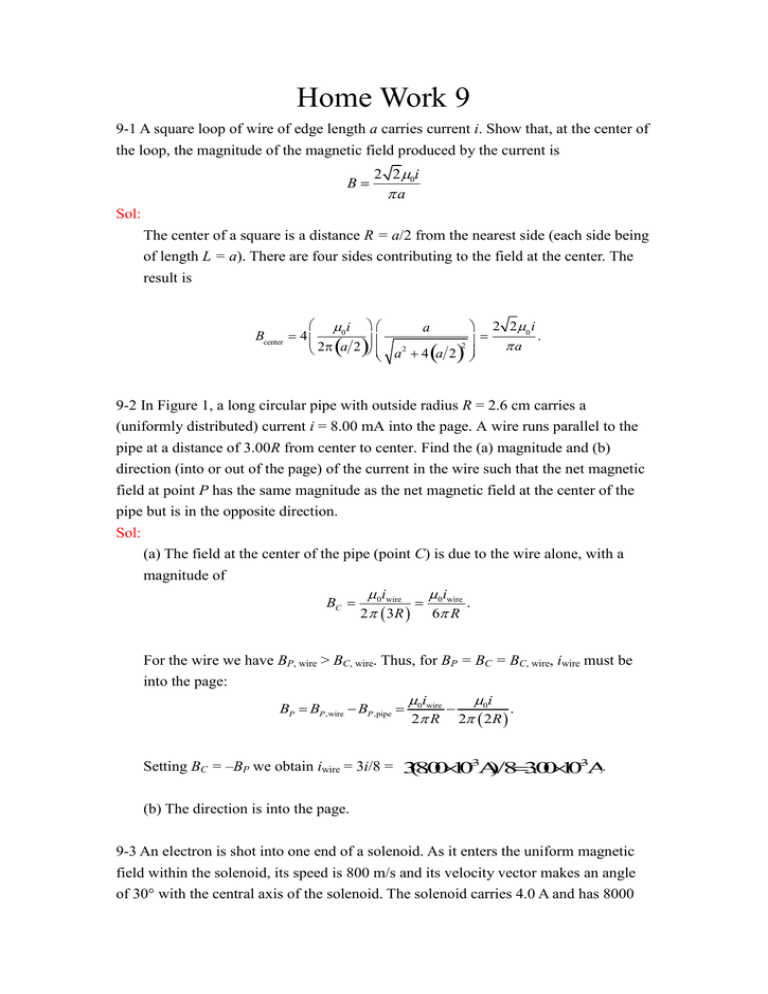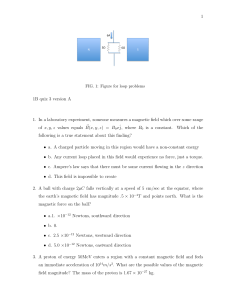Home Work 9
advertisement

Home Work 9 9-1 A square loop of wire of edge length a carries current i. Show that, at the center of the loop, the magnitude of the magnetic field produced by the current is B 2 2 0i a Sol: The center of a square is a distance R = a/2 from the nearest side (each side being of length L = a). There are four sides contributing to the field at the center. The result is 0 i 2 2 i a Bcenter 4 a . 2 2 a 2 a 2 4 a 2 9-2 In Figure 1, a long circular pipe with outside radius R = 2.6 cm carries a (uniformly distributed) current i = 8.00 mA into the page. A wire runs parallel to the pipe at a distance of 3.00R from center to center. Find the (a) magnitude and (b) direction (into or out of the page) of the current in the wire such that the net magnetic field at point P has the same magnitude as the net magnetic field at the center of the pipe but is in the opposite direction. Sol: (a) The field at the center of the pipe (point C) is due to the wire alone, with a magnitude of i i BC 0 wire 0 wire . 2 3R 6 R For the wire we have BP, wire > BC, wire. Thus, for BP = BC = BC, wire, iwire must be into the page: BP BP ,wire BP ,pipe 0iwire 0i . 2 R 2 2R Setting BC = –BP we obtain iwire = 3i/8 = 3(8.00103A )/83.00103A. (b) The direction is into the page. 9-3 An electron is shot into one end of a solenoid. As it enters the uniform magnetic field within the solenoid, its speed is 800 m/s and its velocity vector makes an angle of 30° with the central axis of the solenoid. The solenoid carries 4.0 A and has 8000 turns along its length. How many revolutions does the electron make along its helical path within the solenoid by the time it emerges from the solenoid's opposite end? (In a real solenoid, where the field is not uniform at the two ends, the number of revolutions would be slightly less than the answer here.) Sol: As the problem states near the end, some idealizations are being made here to keep the calculation straightforward (but are slightly unrealistic). For circular motion (with speed, v, which represents the magnitude of the component of the velocity perpendicular to the magnetic field [the field is shown in Fig. 29-19]), the period is (see Eq. 28-17) T = 2r/v = 2m/eB. Now, the time to travel the length of the solenoid is t L / v where v|| is the component of the velocity in the direction of the field (along the coil axis) and is equal to v cos where = 30º. Using Eq. 29-23 (B = 0in) with n = N/L, we find the number of revolutions made is t /T = 2.6 106. 9-4 Figure 2 shows a cross section of a long cylindrical conductor of radius a = 4.00 cm containing a long cylindrical hole of radius b = 1.50 cm. The central axes of the cylinder and hole are parallel and are distance d = 2.00 cm apart; current i = 5.25 A is uniformly distributed over the tinted area. (a) What is the magnitude of the magnetic field at the center of the hole? (b) Discuss the two special cases b = 0 and d = 0. Sol: (a) The magnetic field at a point within the hole is the sum of the fields due to two current distributions. The first is that of the solid cylinder obtained by filling the hole and has a current density that is the same as that in the original cylinder (with the hole). The second is the solid cylinder that fills the hole. It has a current density with the same magnitude as that of the original cylinder but is in the opposite direction. If these two situations are superposed the total current in the region of the hole is zero. Now, a solid cylinder carrying current i, which is uniformly distributed over a cross section, produces a magnetic field with magnitude B 0 ir 2 R 2 at a distance r from its axis, inside the cylinder. Here R is the radius of the cylinder. For the cylinder of this problem the current density is J i i , 2 A a b2 c h where A = (a2 – b2) is the cross-sectional area of the cylinder with the hole. The current in the cylinder without the hole is ia 2 a 2 b2 and the magnetic field it produces at a point inside, a distance r1 from its axis, has magnitude I1 JA Ja 2 0 I1r1 0ir1a 2 0 ir2 B1 . 2 2 2 2 2 a 2 a a b 2 a 2 b2 The current in the cylinder that fills the hole is ib2 I 2 Jb 2 a b2 and the field it produces at a point inside, a distance r2 from the its axis, has magnitude 2 0 I 2r2 0ir2 b2 0ir2 B2 . 2 2 2 2 2 b 2 b a b 2 a 2 b2 At the center of the hole, this field is zero and the field there is exactly the same as it would be if the hole were filled. Place r1 = d in the expression for B1 and obtain (4107 T m/A)5.25A(0.0200m) B 1.53105T 2 2 2 2 2[(0.0400m) (0.0150m) ] 2 a b 0id for the field at the center of the hole. The field points upward in the diagram if the current is out of the page. (b) If b = 0 the formula for the field becomes B 0id 2 a 2 This correctly gives the field of a solid cylinder carrying a uniform current i, at a point inside the cylinder a distance d from the axis. If d = 0 the formula gives B = 0. This is correct for the field on the axis of a cylindrical shell carrying a uniform current. 9-5 In Fig. 3, an arrangement known as Helmholtz coils consists of two circular coaxial coils, each of N turns and radius R, separated by distance s. The two coils carry equal currents i in the same direction. Show that the first derivative of the magnitude of the net magnetic field of the coils (dB/dx) vanishes at the midpoint P regardless of the value of s. Why would you expect this to be true from symmetry? This accounts for the uniformity of B near P for this particular coil separation. Sol: The magnitude of the magnetic field on the axis of a circular loop, a distance z from the loop center, is given by Eq. 29-26: B N 0iR2 , 2( R2 z 2 ) 3/2 where R is the radius of the loop, N is the number of turns, and i is the current. Both of the loops in the problem have the same radius, the same number of turns, and carry the same current. The currents are in the same sense, and the fields they produce are in the same direction in the region between them. We place the origin at the center of the left-hand loop and let x be the coordinate of a point on the axis between the loops. To calculate the field of the left-hand loop, we set z = x in the equation above. The chosen point on the axis is a distance s – x from the center of the right-hand loop. To calculate the field it produces, we put z = s – x in the equation above. The total field at the point is therefore N 0iR2 1 1 B 2 . 2 (R x 2 )3/ 2 (R2 x 2 2sx s2 )3/ 2 Its derivative with respect to x is N 0iR2 dB 3x 3(x s) 2 . dx 2 (R x 2 )5/ 2 (R2 x 2 2sx s2 )5/ 2 When this is evaluated for x = s/2 (the midpoint between the loops) the result is N 0iR2 dB 3s / 2 3s / 2 2 2 0 2 2 5/ 2 2 2 5/ 2 dx s/ 2 2 (R s / 4) (R s / 4 s s ) independent of the value of s. Fig.1 Fig.2 Fig.3






